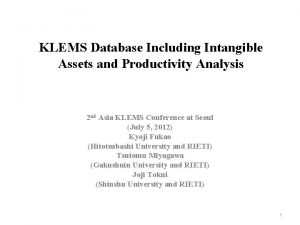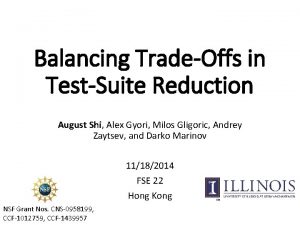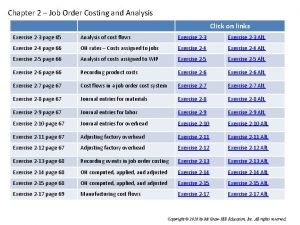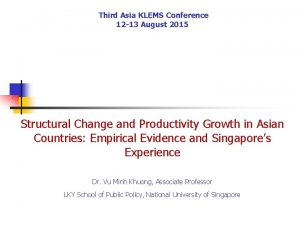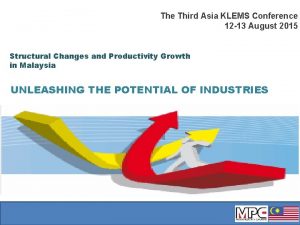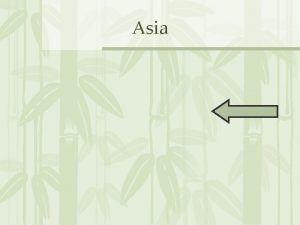Third Asia KLEMS Conference 12 13 August 2015





















- Slides: 21

Third Asia KLEMS Conference 12 -13 August 2015 Structural Change and Productivity Growth in Asian Countries: Empirical Evidence and Singapore’s Experience Dr. Vu Minh Khuong, Associate Professor LKY School of Public Policy, National University of Singapore

Outline n Structural change and economic growth in Asian countries n The case of Singapore n Policy implications 2

Outline n Structural change and economic growth in Asian countries n The case of Singapore n Policy implications 3

Measures of structural change n 4

Effective structural change (ESCI) by Country: Summary statistics 5

Structural change patterns (1) 6

Structural change patterns (2) 7

Structural change patterns (3) 8

Structural change patterns (4) 9

Structural change and growth: The Case of Korea and the Philippines Effective Structural Change ALP Growth 5. 0% 8. 0% 4. 5% 6. 0% 4. 0% 3. 5% 3. 0% Korea 2. 5% Philippines 2. 0% 1. 5% 2. 0% Korea Philippines 0. 0% -2. 0% 1975 1977 1979 1981 1983 1985 1987 1989 1991 1993 1995 1997 1999 2001 2003 2005 2007 2009 2011 0. 0% -6. 0% 1975 1977 1979 1981 1983 1985 1987 1989 1991 1993 1995 1997 1999 2001 2003 2005 2007 2009 2011 -4. 0% 0. 5% 10

Structural change and growth: Empirical evidence (1) y(t)=ALP growth LSDV y(t)=GDP per capita growth GMM LSDV y(t)=Average wage growth GMM LSDV GMM (1) (2) (3) (4) (5) (6) (7) (8) (9) (10) (11) (12) 0. 078 -0. 098 -0. 532 -0. 584 -0. 617** -1. 480* -0. 350 -0. 386* -0. 525 -0. 790 -0. 588* -0. 663** (0. 335) (0. 598) (0. 344) (0. 368) (0. 287) (0. 870) (0. 220) (0. 202) (0. 450) (1. 020) (0. 315) (0. 307) 0. 045 0. 040 0. 197** 0. 211** 0. 243*** 0. 283*** 0. 411*** 0. 480*** 0. 143*** 0. 148*** 0. 203*** 0. 219*** (0. 037) (0. 039) (0. 086) (0. 087) (0. 062) (0. 071) (0. 052) (0. 058) (0. 039) (0. 057) (0. 058) 0. 642*** 0. 594*** 0. 583*** 0. 558*** 0. 204*** 0. 171*** 0. 233*** 0. 208*** 0. 787*** 0. 796*** 0. 977*** 1. 015*** (0. 066) (0. 144) (0. 147) (0. 066) (0. 059) (0. 061) (0. 058) (0. 096) (0. 098) (0. 145) (0. 140) Country FE Yes Yes Yes Time FE No Yes No Yes AR(2) test pvalue - - 0. 874 0. 767 - - 0. 051 0. 129 - - 0. 094 0. 123 0. 273 0. 321 - - 0. 283 0. 386 - - 0. 217 0. 250 - - 633 633 675 675 586 586 Income(t-1) y(t-1) ESCI Adj-R 2 N 11

Structural change and growth: Empirical evidence (2) y(t)=Employment growth LSDV y(t)=GDP growth GMM LSDV y(t)=TFP growth GMM LSDV GMM (1) (2) (3) (4) (5) (6) (7) (8) (9) (10) (11) (12) -1. 220*** -0. 905** 0. 068 0. 162 -1. 120*** -1. 350 -0. 374** -0. 348* 2. 680*** 1. 100 -0. 133 -0. 227* (0. 207) (0. 389) (0. 208) (0. 215) (0. 282) (0. 875) (0. 187) (0. 181) (0. 567) (0. 733) (0. 156) (0. 129) y(t-1) -0. 104 -0. 099 0. 0158 0. 008 0. 253*** 0. 290*** 0. 383*** 0. 443*** 0. 944*** 0. 954*** 1. 003*** 0. 956*** (0. 068) (0. 069) (0. 155) (0. 150) (0. 062) (0. 073) (0. 040) (0. 052) (0. 016) (0. 015) (0. 011) (0. 012) -0. 341*** -0. 345*** -0. 274*** -0. 292*** 0. 211*** 0. 176*** 0. 253*** 0. 215*** 0. 451*** 0. 411*** 0. 379*** (0. 059) (0. 056) (0. 085) (0. 086) (0. 065) (0. 059) (0. 060) (0. 053) (0. 057) (0. 052) (0. 072) (0. 064) Country FE Yes Yes Yes Time FE No Yes No Yes AR(2) test pvalue - - 0. 038 0. 022 - - 0. 056 0. 167 - - 0. 288 0. 785 0. 215 0. 229 - - 0. 266 0. 376 - - 0. 974 0. 980 - - 674 674 675 675 564 564 Income(t-1) ESCI Adj-R 2 N 12

Outline n Structural change and economic growth in Asian countries n The case of Singapore n Policy implications 13

Structural change and growth: The Case of Singapore 14

The contribution to ALP growth by sector, 2000 -2012: Singapore vs. other Asian economies ALP growth Agriculture Mining Manufacturing Construction Utility Trade Transport Finance Community services Total services China 9. 1% 5. 2 6. 0 33. 3 7. 5 2. 4 12. 8 6. 3 11. 5 15. 0 45. 6 India 5. 2% 5. 2 1. 1 15. 4 9. 5 1. 3 20. 0 11. 4 23. 9 12. 2 67. 5 Country China-India Advanced economies Contribution by Sector (Total=100) Hong Kong 2. 7% -0. 1 0. 0 -3. 6 -1. 4 0. 3 44. 4 9. 5 47. 0 3. 9 104. 7 Singapore 1. 7% -0. 1 0. 0 23. 0 -1. 7 0. 0 30. 7 2. 3 36. 8 9. 0 78. 7 Korea, Rep. 2. 6% -0. 5 -0. 3 49. 8 -0. 3 2. 6 6. 2 9. 9 15. 8 16. 6 48. 5 Taiwan 2. 5% -0. 6 52. 9 -2. 4 0. 7 19. 4 4. 4 12. 7 13. 5 50. 0 Japan 0. 9% -2. 7 -1. 3 38. 9 -22. 9 -6. 5 6. 8 23. 0 7. 5 57. 3 94. 6 ASEAN Brunei -0. 8% -0. 2 109. 3 12. 5 -2. 3 -0. 1 -3. 4 -2. 2 -3. 2 -10. 4 -19. 3 Cambodia 4. 4% 16. 5 1. 8 25. 6 7. 9 0. 9 16. 0 8. 4 9. 7 13. 0 47. 2 Indonesia 3. 5% 8. 5 -2. 6 22. 5 14. 7 1. 2 18. 6 15. 3 10. 2 11. 6 55. 7 Lao PDR 4. 6% 0. 0 0. 0 Malaysia 2. 1% 2. 6 -27. 6 17. 6 3. 1 2. 9 32. 3 13. 7 31. 2 24. 3 101. 5 Myanmar 9. 0% 0. 0 0. 0 Philippines 2. 2% 1. 6 3. 5 13. 4 4. 7 2. 5 20. 8 10. 9 29. 5 13. 0 74. 2 Thailand 2. 5% 3. 1 3. 7 33. 4 1. 8 4. 0 14. 3 10. 3 20. 2 9. 1 54. 0 Vietnam 48. 6 4. 4% 7. 0 0. 2 29. 7 7. 9 6. 7 22. 2 5. 4 9. 8 11. 2 South Asia Bangladesh 2. 5% 1. 7 1. 9 27. 6 11. 9 1. 6 18. 6 15. 6 4. 4 16. 8 55. 3 Nepal 1. 2% 19. 0 0. 7 -9. 8 4. 6 3. 0 -17. 6 28. 5 20. 8 50. 9 82. 6 Pakistan 1. 1% -10. 8 3. 3 46. 9 0. 3 -8. 4 17. 1 -0. 8 11. 0 41. 5 68. 8 Sri Lanka 4. 2% 5. 6 3. 8 14. 9 12. 7 2. 5 20. 4 18. 5 14. 4 7. 2 60. 5 15

The contribution to GDP growth by sector, 2000 -2012: Singapore vs. other Asian economies Country GDP growth Contribution by Sector (Total=100) Agriculture Mining Manufacturing Construction Utility Trade Transport Finance Community & social services Total services China-India China 9. 7% India 7. 0% Advanced economies 7. 7 7. 1 4. 9 -1. 3 32. 3 4. 1 7. 6 1. 9 2. 7 1. 1 14. 9 17. 2 7. 1 11. 0 8. 9 40. 0 13. 9 18. 7 44. 8 86. 9 Hong Kong Singapore Korea, Rep. Taiwan Japan ASEAN 3. 8% 5. 4% 3. 9% 3. 7% 0. 7% -0. 1 -1. 1 -2. 5 0. 5 0. 0 0. 2 3. 3 -0. 1 -1. 2 3. 9 32. 1 39. 5 -10. 4 16. 0 20. 4 -5. 0 -5. 9 6. 8 1. 6 2. 9 3. 2 0. 8 -50. 2 23. 1 -9. 8 13. 6 0. 9 37. 3 7. 4 27. 3 11. 2 14. 9 27. 8 29. 2 47. 9 19. 7 24. 6 15. 5 24. 0 7. 3 26. 2 24. 4 72. 8 83. 7 72. 8 70. 7 64. 8 153. 3 Brunei Cambodia Indonesia Lao PDR Malaysia Myanmar Philippines Thailand Vietnam South Asia Bangladesh Nepal Pakistan Sri Lanka 1. 5% 7. 6% 5. 3% 7. 1% 4. 7% 10. 5% 4. 7% 4. 3% 6. 9% 5. 8% 3. 8% 4. 3% 5. 4% -183. 0 25. 0 11. 0 16. 6 1. 7 72. 2 5. 4 2. 7 11. 4 2917. 5 2. 0 3. 3 5. 6 2. 8 1. 0 0. 3 4. 1 9. 7 -187. 4 18. 1 25. 7 18. 0 24. 8 0. 7 18. 0 28. 1 19. 8 -224. 8 15. 0 10. 0 14. 6 12. 2 1. 6 12. 8 3. 4 39. 0 0. 6 0. 7 0. 2 2. 1 0. 7 2. 7 4. 1 7. 5 -414. 7 19. 2 21. 0 23. 9 12. 7 19. 2 18. 5 20. 3 22. 5 -316. 1 7. 1 9. 6 3. 6 8. 7 2. 1 7. 5 10. 4 4. 8 -346. 5 15. 4 9. 6 8. 4 18. 2 0. 1 19. 2 20. 0 6. 7 -1183. 9 -2. 4 9. 2 16. 8 2. 4 15. 5 7. 4 14. 1 -2261. 2 39. 3 45. 0 56. 3 23. 8 60. 7 58. 1 48. 1 11. 2 11. 7 20. 6 10. 9 1. 4 0. 5 2. 8 4. 8 24. 9 8. 6 17. 1 15. 2 10. 1 3. 8 4. 1 25. 6 2. 3 0. 1 -1. 4 13. 7 34. 2 18. 3 15. 2 10. 9 17. 8 4. 3 11. 5 9. 0 5. 2 10. 2 11. 4 16. 5 18. 1 24. 0 50. 1 75. 2 56. 8 42. 1 16

Growth by sector: Singapore vs. Taiwan Indicator Singapore Taiwan GDP EMP ALP TOTAL 5. 4% 3. 7% 1. 7% 3. 7% 1. 2% 2. 5% Agriculture,hunting,forestry and fishing 0. 9% 7. 1% -6. 3% 0. 5% -2. 6% 3. 0% - -2. 6% -8. 4% 5. 9% Manufacturing 5. 2% 1. 5% 3. 7% 6. 4% 0. 9% 5. 5% Electricity, gas and water supply 3. 8% 2. 7% 1. 1% 2. 6% -0. 2% 2. 8% Construction 3. 3% 3. 2% 0. 0% -0. 4% 0. 1% -0. 5% Wholesale and retail trade, repair of vehicles, hotels and restaurants 5. 6% 3. 8% 1. 8% 3. 1% 1. 2% 1. 9% Transport, storage and communications 4. 0% 3. 4% 0. 6% 3. 1% 0. 2% 2. 9% Financial intermediation, real estate, renting and business activities 5. 3% 5. 6% -0. 3% 2. 5% 2. 8% -0. 2% …Financial intermediation 6. 3% Community, social and personal services 4. 8% 2. 3% 0. 1% Mining and quarrying 1. 5% 4. 9% -0. 1% 2. 5% 17

Singapore’s financial sector: key success factors n n Opportunities: the rise of Asia Strategy n n Positioning: Regional hub World-class infrastructure and labor force Top-notch business environment Execution n MAS The role of government: Regulating; Enabling; Stabilizing; and Legitimating ICT 18

Outline n Structural change and economic growth in Asian countries n The case of Singapore n Policy implications 19

Policy implications n n Structural change plays a important role in driving economic growth, especially in developing countries. The government can foster structural change through different policy channels: n n n n Openness (to trade and FDI); Investment incentives; Facilitation of movement of productive factors (labor, capital, land); Improvement of business environment and labor force quality; Knowledge acquisition and innovation; and Integration within the economy and coordination among government agencies. The government should pay a special attention to manufacturing, trade, and financial services -- the three most important sectors in driving economic growth. 20

Thank You! 21
 Klems database
Klems database Eu klems database
Eu klems database Eu klems
Eu klems Forward caries and backward caries
Forward caries and backward caries Mount and hume classification
Mount and hume classification Insight 2015 conference
Insight 2015 conference Led conference 2015
Led conference 2015 Edge conference 2015
Edge conference 2015 Ecommerce conference asia
Ecommerce conference asia Third party risk management conference 2019 new york
Third party risk management conference 2019 new york 3 round table conference
3 round table conference Fences central idea
Fences central idea Fences themes
Fences themes August shi
August shi August shi
August shi March april june july august
March april june july august Famous testimonies
Famous testimonies 30th august 2005
30th august 2005 Starr company reports the following information for august.
Starr company reports the following information for august. August journal prompts
August journal prompts Propast venecije august šenoa
Propast venecije august šenoa Do que miranda amiga de via chamava august
Do que miranda amiga de via chamava august
